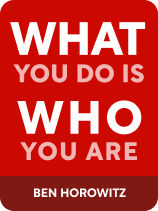

This article is an excerpt from the Shortform book guide to "What You Do Is Who You Are" by Ben Horowitz. Shortform has the world's best summaries and analyses of books you should be reading.
Like this article? Sign up for a free trial here .
When it comes to decision-making in your organization, how much power do you and your employees have? How fast are decisions made? What happens immediately after a decision is made?
In his book What You Do Is Who You Are, Ben Horowitz discusses how decision-making is an aspect of your organization’s culture. As the leader, you set the tone for how decisions are made. Horowitz identifies three choices you make that determine what kind of decision-making culture you build.
Keep reading for details on these three choices.
Organizational Decision-Making
How you make important decisions is shaped by your culture because it is an expression of your leadership style. At the same time, it shapes your culture because it determines your priorities and how employees and leaders interact with each other. According to Horowitz, leaders make three choices that set the tone for organizational decision-making: autocracy versus democracy, speed versus accuracy, and top-down versus bottom-up.
Autocracy, Consensus-Building, or Democracy
The first choice Horowitz believes a leader has to make is how much power she will ultimately have—a choice among autocracy, consensus-building, and democracy.
Autocracy
In this first decision-making style, you make the decision on your own. Horowitz argues that this style fosters a culture of efficiency because it doesn’t waste any time, but it doesn’t take advantage of the insight other people have so it disempowers everyone other than you. Taken to an extreme, it can become inefficient as everyone needs to wait for you to make a decision.
Consensus-Building
This second decision-making style has you trying to get everyone on the team to agree on a decision. According to Horowitz, it fosters empowerment at the expense of efficiency because it requires a major time commitment, but ensures that everyone participates in the decision. Taken to an extreme, this style can become disempowering because no one can move forward until everyone has had a say and reached a consensus.
Democracy
In this final decision-making style, you hear from everyone on the team who has something to say about the decision, but ultimately make the final call yourself. Horowitz argues that this style fosters a culture that balances efficiency with empowerment because it takes advantage of the insights others have, but ultimately the buck stops with you.
| Deciding How to Decide Each style has its set of advantages and disadvantages, so it might be best to choose an approach according to the specific decision you have in front of you. In Crucial Conversations, Kerry Patterson et al. provide guidelines to choose the right decision-making method for every situation. They suggest considering these four questions before deciding how to decide: Who wants to participate and who will be affected by the decision? Who has information or expertise you might need to make the decision? Who needs to be on board with the final outcome and should therefore be included from the beginning? How many people need to be involved (the fewer, the better)? |
Speed Versus Accuracy
The second choice Horowitz says a leader has to make in regard to decision-making is whether to prioritize speed—making the decision quickly—or accuracy—making sure you arrive at the right final outcome.
Speed
According to Horowitz, companies that favor speed over accuracy in decision-making often make a large volume of decisions. Large companies favor speed because their employees make hundreds of similar decisions each day, and the outcome of one decision impacts the workflow of hundreds of people. In these cases, the potential time lost in protracted decision-making is a greater liability than the potential mistake. If you make a mistake, it’s better to make it quickly, realize it’s a mistake, and then fix it armed with the valuable information the mistake has given you. The alternative would be to spend a lot of time figuring out the right course of action—while hundreds of people wait for you to decide—and even then there’s no guarantee that you’ll make the right decision.
Accuracy
Horowitz argues that companies that favor accuracy over speed in decision-making often face a small number of significant decisions. Small companies where the relative impact of each decision is greater favor accuracy. A company with few resources or opportunities to make its business work must ensure every decision brings it closer to its vision. It’s better to spend significant time making sure you make the right decision than to rush because—unlike a large company—you don’t have many chances.
Horowitz clarifies that both large and small companies favor accuracy in situations that involve financial or reputational risk. Whenever the outcome of the decision will determine the success of a venture, the wrong decision would put the company in danger. Similarly, if the decision affects important elements of the brand’s promise—the value the brand has committed itself to delivering—the wrong decision could negatively affect clients’ perception of the brand and company, potentially leading to financial loss.
(Shortform note: The choice between speed and accuracy might remind leaders of the choice between waterfall and agile project management methodologies. While waterfall’s rigid approach to projects can stifle speed, its focus on documentation and clear requirements helps keep a tighter rein on outcomes. On the other hand, agile’s focus on flexibility helps projects deliver value more quickly but doesn’t always ensure the final outcome is what was intended at the beginning. Similarly, feeling that your company’s culture of decision-making has to choose between either accuracy or speed is a false choice. In practice, organizations decide which to favor depending on the decision at hand, much like choosing between waterfall and agile depends on the nature of the specific project to be executed.)
Top-Down Versus Bottom-Up
The final choice Horowitz says a leader has to make in regard to her organization’s culture of decision-making is how much decision-making power to give her employees—a choice between making decisions top-down or bottom-up.
Top-Down
When decision-making is top-down, leaders make decisions with a bird’s-eye view of the organization. They are able to see how the decision’s effect ripples across the company, and they can ensure that all teams receive information about the decision and that it is in line with the company’s strategy. However, Horowitz cautions that they might disregard important information that lower-level employees have. Also, they can create bottlenecks because employees whose work depends on the decision need to wait for them to decide.
Bottom-Up
When decision-making is bottom-up, Horowitz says lower-ranking employees make decisions considering the insight they have on aspects of the business that they work closely with. This empowers employees, which in turn motivates them to be more involved and take ownership of the company’s success. However, this type of decision-making might mean that different teams make decisions independently and don’t communicate them to each other because they don’t have the view from the top to see how their decisions affect other teams.
| Dispersed Decision-Making In No Rules Rules, Reed Hastings and Erin Meyer describe the decision-making process at Netflix: a dispersed decision-making system that alleviates some of the shortcomings of bottom-up decision-making without reverting to top-down. To achieve that balance, the system outlines four steps for employees to follow: Step 1: Get feedback. Employees share their idea with managers and colleagues, gathering input and making adjustments based on that input. If employees get feedback from managers and colleagues outside of their area or department, they can avoid working in silos. Step 2: Test it out. Employees bring their idea down to a smaller scale in order to test it out before committing large amounts of resources and time into a full-blown version. Step 3: Take the lead. Employees who come up with an idea become its project managers. Step 4: Share successes and failures. After the process has been executed, project leads share the success or failure with the rest of the organization. If the project fails, they write an open memo detailing what happened and what they learned from the experience. This step also aids communication by ensuring the entire company gets to learn from each others’ mistakes. |
After Making the Decision
Regardless of how you arrive at a decision, Horowitz says the moment that makes or breaks your organization’s culture is right after having made the decision. How leaders communicate the decision to employees and how leaders manage their reactions can strengthen or debilitate the culture. If a leader below the CEO level, such as a manager, lets employees know that they personally disagree with the decision, they create an opening for employees to question or challenge decisions.
According to Horowitz, everyone below the CEO must be unwavering in their adherence to the decision from the moment it’s made—even if they disagree with it. This prevents giving employees the opportunity to doubt the leaders’ decision-making and disrupt cultural cohesion. To do so, middle managers should accept the decisions leadership has made, vocally support them, and be able to explain the reasoning to anyone who questions them.
[Shortform note: The behavior Horowitz is advocating here contradicts his advice to foster the freedom to speak up about problems. Other experts also hold a different opinion, such as Ronald Heifetz (The Practice of Adaptive Leadership) who argues that leaders should let employees come to their own conclusions rather than always do whatever the leader will like best. This will allow the organization to harness the intelligence of all of its members, rather than rely on a select group of people to make decisions for everyone else.]
———End of Preview———
Like what you just read? Read the rest of the world's best book summary and analysis of Ben Horowitz's "What You Do Is Who You Are" at Shortform .
Here's what you'll find in our full What You Do Is Who You Are summary :
- The three reasons leaders should care about culture
- How a sense of purpose boosts employees' performance
- What the Samurai and Genghis Khan can teach you about leadership






